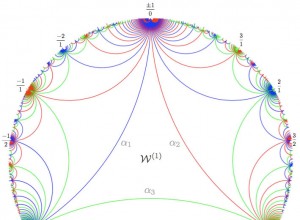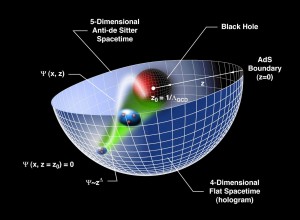There cannot be a language more universal, more free from errors and obscurities…more worthy to express the invariable relations of all natural things than mathematics. It interprets all phenomena by the same language, as if to attest the unity and simplicity of the plan of the universe, and to make still more evident that unchangeable order, which presides over all natural causes. ~ Joseph Fourier!
Although the standard received view of inflationary cosmology does explain a lot, one tends to forgets that it is a ‘theory’ with many more problems than it purportedly solves, and at best is still conjectural as it has, both, a ‘Higgs’ problem and monopole problem that the standard model of physics cannot solve: one needs supersymmetric brane-based theory to solve all of the problems listed above. Here, I will raise deeper problems for inflationary cosmology based on my work in mathematical physics and M-Theory, and derive, from it, an inflationary scenario. To start, let us look at the Friedman-Robertson-Walker ‘Einstein’ metric:
![]()
with
![Rendered by QuickLaTeX.com \[{f_K}(\tau ) = \left\{ {\begin{array}{*{20}{c}}{{{\sqrt K }^{ - 1}}\sin \left( {\tau \sqrt K } \right)\quad K > 0}\\{\tau \quad K = 0}\\{{{\sqrt {\left| K \right|} }^{ - 1}}\cos \left( {\tau \sqrt {\left| K \right|} } \right)\quad K < 0}\end{array}} \right.\]](https://www.georgeshiber.com/wp-content/ql-cache/quicklatex.com-13ab2f541b5b042d382fb81306992b7d_l3.png)
the Yukawa interactional measure of curvature near the singularity
![]()
describes the ‘inflationary’ expansion,
and
![]()
measures comoving distances, with
![]()
being the inflaton scalar field and ![]() being the Gaussian curvature of space, and let
being the Gaussian curvature of space, and let ![]() be the Hubble constant at ‘present’ time, relative as it is, near the singularity. The problem now is clear: given the FRW metric, ‘time(s)’, in the conformal inflationary integral
be the Hubble constant at ‘present’ time, relative as it is, near the singularity. The problem now is clear: given the FRW metric, ‘time(s)’, in the conformal inflationary integral
![]()
get(s) arbitrarily close to the initial singularity
![Rendered by QuickLaTeX.com \[\not \Delta \varsigma = \underbrace {\int_0^{\delta {f_K}} {\frac{{d{t^ \circ }}}{{a({t^ \circ })}}} }_{{\rm{Quantum Gravity}}} + \underbrace {\int_{\delta f}^{{f_K}} {\frac{{d{t^ \circ }}}{{a({t^ \circ })}}} }_{{\rm{Inflation}}}\]](https://www.georgeshiber.com/wp-content/ql-cache/quicklatex.com-8ef0e4f396ebd8f19cd7254605943038_l3.png)
and by wave-particle duality, the inflaton-‘wave’, by quantum tunnelling, will propagate at faster than the speed of light; therefore,
![Rendered by QuickLaTeX.com \[\underbrace {\int_{\delta f}^{{f_K}} {\frac{{d{t^ \circ }}}{{a({t^ \circ })}}} }_{{\rm{Inflation}}}\]](https://www.georgeshiber.com/wp-content/ql-cache/quicklatex.com-541ac3a06b18ebbfa8ae9c5fcae38397_l3.png)
implies that the inflationary phase occurred faster than the speed of light. For obvious reasons, both are incoherent ‘notions’. Moreover, since the Hilbert-energy operator acts cohomologically left-invariantly on
![Rendered by QuickLaTeX.com \[\underbrace {\int_0^{\delta {f_K}} {\frac{{d{t^ \circ }}}{{a({t^ \circ })}}} }_{{\rm{Quantum Gravity}}}\]](https://www.georgeshiber.com/wp-content/ql-cache/quicklatex.com-0bcdc4c919928b1ccb5e714926edc98a_l3.png)
it follow by the Heisenberg energy-time uncertainty relation, that ‘time‘ is in quantum superpositionality, and thus
![Rendered by QuickLaTeX.com \[\frac{d}{{d{t^ \circ }}}\underbrace {\int_0^{\delta {f_K}} {\frac{{d{t^ \circ }}}{{a({t^ \circ })}}} }_{{\rm{Quantum Gravity }}}d\,\Omega (a({t^ \circ })\]](https://www.georgeshiber.com/wp-content/ql-cache/quicklatex.com-55adb95cae6b240e25463dff1e0176f6_l3.png)
provably has no solution: that implies, rather catastrophically, that the Big Bang could not have occurred: well, maybe not so catastrophically, since I have a quantum cosmological model that eliminates the Big Bang from the ‘cosmic-picture’, but that is for another time. To further realize the severity of the problem, note that
![]()
exhibits exact time-symmetry, and so any solution to it implies the existence of a solution equally describing a deflationary cosmological phase, and hence an non-expansionary universe, that is moreover contracting back in time and crossing time equals zero!!! Thus, the inflaton scalar field ![]() , coupled to the Einstein gravity action
, coupled to the Einstein gravity action
![Rendered by QuickLaTeX.com \[S = \int {{d^4}x\sqrt { - {g_{\mu \nu }}} } \left[ {\frac{{M_{{\rho _{{\rm{Critical}}}}}^{(0)}}}{2}{R_{{\rm{Ricci}}}} - \frac{1}{2}{g^{\mu \nu }}{{\not \partial }_\mu }{\phi _I}{{\not \partial }_\nu }{\phi _I} - V({\phi _I})} \right]\]](https://www.georgeshiber.com/wp-content/ql-cache/quicklatex.com-2f8887b78c56957f9092df8ff4a04d64_l3.png)
with
![]()
will not be integrable! Enter a SuSy-based branes theory of inflationary cosmology, with initial boundary conditions a D4-brane’s 5-Dimensional worldvolume with supersymmetric covariance that realizes inflation in a super-Kähler background spacetime geometry which is determined topologically by a stack of D6-branes. The inflaton scalar field is then finite and does not lead to deflation and past-singularity time contraction: and mainly due to the fact that its wave-function is Seiberg–Witten invariant, and thus stable in the D6-brane BPS configuration. Solving the ‘No-Solution’ Problem to the Einstein-Inflaton action is just a matter of solving the Witten-D6-brane-ing of it:
![Rendered by QuickLaTeX.com \[{S_{Wb6}} = \left[ {\left[ {\int {{d^4}x\sqrt { - {g_{\mu \nu }}} \frac{{M_{{\rho _{{\rm{Critical}}}}(0)}^{(2)}}}{2}{R_{{\rm{Ricci}}}} - \frac{1}{2}{g^{\mu \nu }}{{\not \partial }_\mu }{\phi _I}{{\not \partial }_\nu }{\phi _I}V({\phi _I})} } \right]} \right]_{D6{\rm{ - BRANE}}}^{\delta {f_K}}\]](https://www.georgeshiber.com/wp-content/ql-cache/quicklatex.com-dc3bfd4fcd0786117791cdafcad63d40_l3.png)
via SuGra axionic and dilatonic field exhibiting on-shell gauge invariance. Thus, ![]() will have values in ‘real’ time that breaks the inflation/deflation symmetry, and by Goldstone’s theorem, the inflatonic ‘Goldstino‘ breaks SuSy, and that, by the superpartner of the inflaton, solves, both, the time-symmetry and time-superpositionality problems. To show that, one must work in a stack of ND6-brane setting, with a 4 stack of NS5 branes that stabilize the inflaton wave-function, and thus it does not, as it should, propagate faster than the speed of light, and a D4-brane whose 5-Dimensional worldvolume serving as a solution to the first part of
will have values in ‘real’ time that breaks the inflation/deflation symmetry, and by Goldstone’s theorem, the inflatonic ‘Goldstino‘ breaks SuSy, and that, by the superpartner of the inflaton, solves, both, the time-symmetry and time-superpositionality problems. To show that, one must work in a stack of ND6-brane setting, with a 4 stack of NS5 branes that stabilize the inflaton wave-function, and thus it does not, as it should, propagate faster than the speed of light, and a D4-brane whose 5-Dimensional worldvolume serving as a solution to the first part of
![Rendered by QuickLaTeX.com \[\not \Delta \varsigma = \underbrace {\int_0^{{\delta _{{f_K}}}} {\frac{{d{t^ \circ }}}{{a({t^ \circ })}}} }_{{\rm{Quantum Gravity}}} + \underbrace {\int_{\delta f}^{{f_K}} {\frac{{d{t^ \circ }}}{{a({t^ \circ })}}} }_{{\rm{Inflation}}}\]](https://www.georgeshiber.com/wp-content/ql-cache/quicklatex.com-f3eb1fd84b7da3d7c16d67ad36b8a583_l3.png)
Now, to derive the inflaton scalar field, note that a rotation of a D4-brane on the ![]() plane of its 5-Dimensional worldvolume coordinates will be equivalent to generating the Fayet-Iliopoulos super-Kähler term of the 4D-brane’s 5-Dimensional worlvolume. Given that a Dp-brane is always a source of (p+1)-RR hyper fields in M-Theory, solutions of Dp-brane 5-Dimensional worldvolume propagation in spacetime can be obtained by a super Yukawa coupling of the inflaton with its supersymmetric partner in the SuGra theory, giving us the action
plane of its 5-Dimensional worldvolume coordinates will be equivalent to generating the Fayet-Iliopoulos super-Kähler term of the 4D-brane’s 5-Dimensional worlvolume. Given that a Dp-brane is always a source of (p+1)-RR hyper fields in M-Theory, solutions of Dp-brane 5-Dimensional worldvolume propagation in spacetime can be obtained by a super Yukawa coupling of the inflaton with its supersymmetric partner in the SuGra theory, giving us the action
![Rendered by QuickLaTeX.com \[\begin{array}{c}{S_0} = \frac{{M_s^8}}{{{{(2\pi )}^7}}}\int {{d^{10}}} x\sqrt { - {g_{\mu \nu }}} \cdot \\{\left[ {{e^{ - 2{\phi _I}}}\left( {{R_{{\rm{Ricci}}}} + 4(\nabla {\phi _I}} \right)} \right.^2} - \frac{1}{{2 \cdot 3!}}H_0^2 - \\\frac{2}{{(8 - p)!}}F_{P + 2}^2 + d\,\Omega (a({t^ \circ })\left. { + ...} \right]\end{array}\]](https://www.georgeshiber.com/wp-content/ql-cache/quicklatex.com-7d384232c8bec571fbafe10299dc1a35_l3.png)
with
![]()
which acts like a 3-form strength field, and ![]() is a (p+2)-form RR field strength. Then a solution that has N coincident Dp-branes in string worldsheet Witten topology, with p < 7, is given uniquely by
is a (p+2)-form RR field strength. Then a solution that has N coincident Dp-branes in string worldsheet Witten topology, with p < 7, is given uniquely by
![]()
with ![]() a harmonic function in the transverse space to the Dp-brane’s p+1 Dimensional worldvolume, and is generally
a harmonic function in the transverse space to the Dp-brane’s p+1 Dimensional worldvolume, and is generally
![]()
with
![]()
and preserving all the Kähler-Gibbs supercharges. Note now that an NS5 brane generates an antisymmetric 2-form field ![]() in the NS-NS sector of the theory: so, a 10-Dimensional solution, with N5-coincident NS5 brane rotating in the
in the NS-NS sector of the theory: so, a 10-Dimensional solution, with N5-coincident NS5 brane rotating in the ![]() plane is
plane is
![]()
with
![Rendered by QuickLaTeX.com \[{e^{{\phi _I}}} = {g_s}\left( {1 + {N_s}\sum\limits_j {\frac{1}{{M_s^2{{(\widetilde \tau - {\tau ^\dagger })}^2}}}} } \right){H_{IJK}} = {\varepsilon _{IJKM}}\not \partial {\phi _I}\]](https://www.georgeshiber.com/wp-content/ql-cache/quicklatex.com-10321d4f00ac03ef398cfda108192167_l3.png)
and ![]() represent the
represent the ![]() plane transverse to the NS5 brane, and
plane transverse to the NS5 brane, and ![]() refers to the positions in NS5 brane’s 6-Dimensional worldvolume. To proceed further, notice that D4-branes are perpendicular to NS5 branes and thus SuSy is NS5 gauge invariant: that implies, as required by unitarity, that the worldvolume dynamics of Dp-branes are given by the Dirac-Born-Infeld action
refers to the positions in NS5 brane’s 6-Dimensional worldvolume. To proceed further, notice that D4-branes are perpendicular to NS5 branes and thus SuSy is NS5 gauge invariant: that implies, as required by unitarity, that the worldvolume dynamics of Dp-branes are given by the Dirac-Born-Infeld action
![]()
and
![Rendered by QuickLaTeX.com \[\left\{ {\begin{array}{*{20}{c}}{{g_{ab}}(\sigma ) = \frac{{\not \partial {X^M}}}{{\not \partial {\sigma ^a}}}\frac{{\not \partial {X^N}}}{{\not \partial {\sigma ^b}}}{G_{MN}}(X(\sigma ))}\\{{B_{ab}}(\sigma ) = \frac{{\not \partial {X^M}}}{{\not \partial {\tau ^a}}}\frac{{\not \partial {X^N}}}{{\not \partial {\sigma ^b}}}{B_{MN}}(X(\sigma ))}\end{array}} \right.\]](https://www.georgeshiber.com/wp-content/ql-cache/quicklatex.com-e5c794d7e92ad1ec4bbc554857dc9ba0_l3.png)
being the metric and anti-symmetric tensor on the Dp-brane, and ![]() the gauge field strength living on the Dp-brane’s p+1 Dimensional worldvolume. So, in
the gauge field strength living on the Dp-brane’s p+1 Dimensional worldvolume. So, in ![]() ,
,
![]()
and so, we can now, by transversality, derive the D4-brane action
![Rendered by QuickLaTeX.com \[\begin{array}{c}{S_{D4}} = \frac{{{T_4}}}{{{g_s}}}\int {{d^4}} x\int {d{x_\theta }} \left[ {{{\left( {{{\cos }^2}\theta + {f^{ - 1}}{{\sin }^2}\theta } \right)}^{1/2}} + \frac{1}{2}\sum {{{\not \partial }_a}{X^i}\not \partial {X^i}} } \right] \approx \\\frac{{ - {T_4}}}{{{g_s}}}\int {{d^4}} x\int {dx_6^2} \left[ {1 - \frac{{{g_s}N{{\sin }^2}\theta }}{{4{M_s}(\tau )}} + \frac{1}{2}\sum\limits_i {{{\not \partial }_a}{X^i}\not \partial {X^i}} } \right]\end{array}\]](https://www.georgeshiber.com/wp-content/ql-cache/quicklatex.com-9c8f9b35e13f9e83f2a8aadb88e2fbe6_l3.png)
with
![]()
We introduce now a non-zero angular Seiberg–Witten potential
![]()
Why: because a non-zero Seiberg–Witten potential implies the existence of stable BPS states, hence solving both, the inflaton time-symmetry problem of deflation and contraction, as well as the Heisenberg ‘time’-superpositionality problem that is catastrophic for solving
![Rendered by QuickLaTeX.com \[\not \Delta \varsigma = \underbrace {\int_0^{{\delta _{{f_K}}}} {\frac{{d{t^ \circ }}}{{a({t^ \circ })}}} }_{{\rm{Quantum Gravity}}} + \underbrace {\int_{\delta f}^{{f_K}} {\frac{{d{t^ \circ }}}{{a({t^ \circ })}}} }_{{\rm{Inflation}}}\]](https://www.georgeshiber.com/wp-content/ql-cache/quicklatex.com-f3eb1fd84b7da3d7c16d67ad36b8a583_l3.png)
Now, since the full effective 4-Dimensional Seiberg–Witten potential is
![Rendered by QuickLaTeX.com \[\begin{array}{c}V_{SW}^{4d} = 2{\sin ^2}\frac{\theta }{2}\frac{{M_s^5{R^6}_{Ricci}}}{{{{(2\pi )}^4}g_s^2}}\left[ {1 - \frac{{N{{\cos }^2}\frac{\theta }{2}}}{{2{{(2\pi )}^2}}}\frac{{M_s^{3/2}{R_{Ricci}}}}{{{\phi _I}}}} \right] \equiv \\{M_{{\phi _I}}}^4\left( {1 - \frac{{{m^2}}}{{{\phi _I}}}} \right)\end{array}\]](https://www.georgeshiber.com/wp-content/ql-cache/quicklatex.com-e7ec84609261180e669ac9b79e680c4b_l3.png)
and, solving gives us a stable, finite, non-deflationary non-contracting inflatonic wave-equation, and since any solution entails that
![Rendered by QuickLaTeX.com \[{\phi _I} = \frac{{M_s^{5/2}R_{Ricci}^{1/2}}}{{{{(2\pi )}^2}{g_s}}} \cdot \tau \]](https://www.georgeshiber.com/wp-content/ql-cache/quicklatex.com-5a0cc24f7a5a28882eba768f4e3ae2c1_l3.png)
holds, we have the result we need: the Seiberg–Witten potential vanishes completely, and hence the SuSy superpartner of the inflaton will dynamically generate the inflationary cosmological phase, since
![]()
and the e-folds ![]() stacks deriving inflatonic dynamics leads to smoothness and flatness, as can be seen from the identity
stacks deriving inflatonic dynamics leads to smoothness and flatness, as can be seen from the identity
![]()
giving us the Planck scale mass of the inflaton and its SuSy superpartner, and thus, as mathematics dictates, the decay rate of the inflaton is
![Rendered by QuickLaTeX.com \[{\rm K}({\phi _I}) \sim G_N^2\frac{{{{({M^4})}^{5/4}}}}{{M_s^6{L_4}{L_5}...{L_{10}}}} \sim {10^{ - 20}}\left( {\frac{{N{{\cos }^2}\frac{\theta }{2}{g_s}}}{{2\sin \frac{\theta }{2}}}} \right){\left( {\frac{{{M_s}}}{{{M_P}}}} \right)^{3/4}}{M_P}\]](https://www.georgeshiber.com/wp-content/ql-cache/quicklatex.com-4cc8cb45f480b3c048b10310b0bd5976_l3.png)
with
![]()
being the 4-Dimensional Newtonian constant and ![]() label the size of the SuGra compactification space dimension of the brane-coupled strings!
label the size of the SuGra compactification space dimension of the brane-coupled strings!
Summing, we have derived, while solving deeply severe problems, inflationary cosmology from SuSy superpartners of the inflaton via the Dp-brane with a NSq Dirac-Born–Infeld action: and only in such M-Theoretic setting can one avoid the above-mentioned catastrophies.
AND LEAVES ALL THE REST TO US




